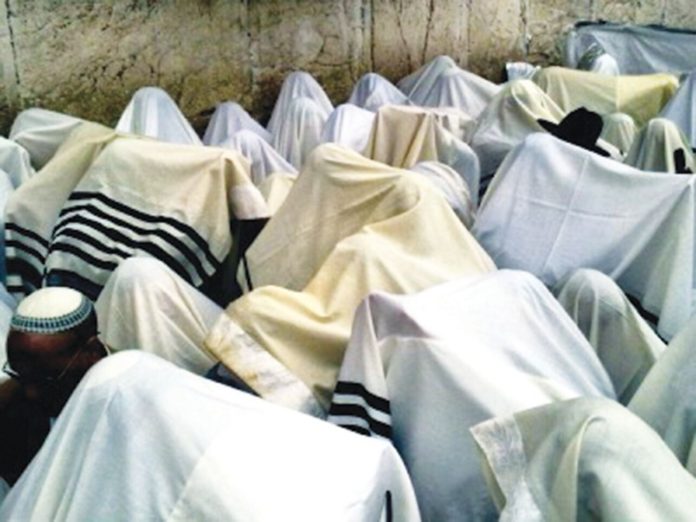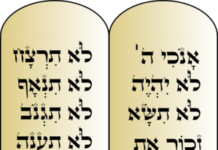We are zocheh to be blessed with Birkas Kohanim, the blessing the Kohanim give the Jewish people, on yomim tovim here in the exile and every single day in Eretz Yisroel. Before the Kohanim begin Birkas Kohanim, the chazzan gives an amazing introduction to their blessing. He says, “Bless us with the triple blessing of the Torah through Moshe which is spoken from the mouth of Aharon and his sons, Your holy people, as it says, ‘May Hashem bless you…’” On a simple level, it is called the “triple blessing” because it uses Hashem’s four letter name three times.
The midrash (Tanchuma Bamidbar 8) explains that the Jewish people were not happy that Hashem told the Kohanim to bless them. According to the midrash:
The Jewish people said before the Holy One blessed is He: “Master of the world, you have commanded the Kohanim to bless us. We need no one’s blessings but Yours! We only want to be blessed from Your mouth!” As it says (Devarim 26:15), “Look down from Your holy dwelling place.” The Holy One said to them, “Even though I have told the Kohanim to bless you, I am standing with them and blessing you.” Therefore, the Kohanim stretch out their hands as if to say, “The Holy One is standing behind us!” Thus it says (Shir Hashirim 2:9), “Behold He is standing behind our wall, watching from the windows and peeking from between the lattices,” from between the fingers of the Kohanim.
The Ksav Sofer (the son of the Chasam Sofer) offers a beautiful explanation of the Jewish people’s objection to Birkas Kohanim. He explains that human beings cannot truly understand what “blessings” will truly be good for a person. Everyone wants the blessings of wealth and long life, for example. The truth is that very often, these things are not good for a person. I have read that for the majority of people who win the lottery, their lives turn out very badly afterward. As it says in Koheles 5:12, “Wealth is kept by its owner for his harm.” Others detest their own old age and wish they could end their lives, although they are prevented from doing so because it is forbidden.
According to the Ksav Sofer, the Jewish people were saying that no human being knows whether wealth, long life, or any other “blessing” is truly good for a person. Only Hashem, who looks into someone, sees his entire past and all of his past lives, as well as his future, can truly know what is good for a person. That is why Hashem told the Jewish people He would stand with the Kohanim and bless the people with the specific words of Birkas Kohanim, which are worded generally, and not in the form of specific blessings. It says, “Hashem should bless you and watch over you” generally. It does not say, “Hashem should bless you with wealth.”
For some people, wealth is a blessing, and for others, poverty is the biggest blessing. Such a person’s life would fall apart if he were “blessed” with wealth. That is why the Torah says (Bamidbar 6:23), “Ko, t’varichu es Bnei Yisroel, Thus shall you bless the children of Israel.” The Kohanim may only bless the Jewish people with the general blessings of Birkas Kohanim, through which Hashem will give the people whatever blessings they truly need. They do not have the discretion to “customize” Hashem’s blessings.
The Belzer Rosh Kollel, Rav Friedman, expands on this concept and explains why Birkas Kohanim is called a triple blessing. Rav Friedman emphasized that Hashem’s intention in establishing Birkas Kohanim was (Bamidbar 6:27) “and you shall place My name on the children of Israel and I will bless them.” Rashi there explains that the words “My name” mean that the Kohanim in the Beis Hamikdash should say Birkas Kohanim b’shem Ha’miforash pronouncing the four-letter name of Hashem. That name of Hashem, which is composed of the letters yud hei and vav hei, is an abbreviation of the words “ha’yah, ho’veh, v’y’heiyeh, He was, He is, and He will be.”
This emphasis on Hashem’s eternal presence in the past, the present, and in the future is especially relevant to Birkas Kohanim, where only G-d, who can look into a person’s past, see inside of him in the present, and see how the blessing will affect him in the future, knows which blessings are truly good for a person. As Shlomo Hamelech said in Mishlei 10:22, “Hashem’s blessing will make one wealthy and will not add any sadness with it.” Because only Hashem’s blessings, and not any human being’s blessings, come with an ability to see into the recipient’s past, present, and future, only Hashem’s blessings carry no sadness with them. Therefore, because Hashem stands with the Kohanim and they bless the people with Hashem’s four letter name, which invokes His eternal nature that looks into the past, present, and future of the recipients of the blessing, Birkas Kohanim is truly a blessing.
Hashem’s triple vision of the each person’s past, present, and future is therefore why Birkas Kohanim is called a triple blessing.
The Chozeh (“Seer”) of Lublin, from the time he was a child, had the gift of “seeing” things no one else could see. As a child walking through the streets, he would tell people their thoughts and sins by looking at their foreheads. Because of that, the people began wearing their hats over their foreheads so he would not see their deepest secrets. His parents also used to place a kerchief over his eyes when he went out into the streets to prevent him from revealing everything about the people they passed.
After the Chozeh became well-known, and was a rebbe in Lublin, he once had to leave Lublin for a two or three days. He was concerned about the people who came to him in dire straits for blessings so he asked his close talmid and tzaddik in his own right, the Yid Hakadosh (the “Holy Jew”) from Peshischa, to meet with the people who came to him for blessings in his absence. The Yid Hakadosh protested that he did not have the Chozeh’s eyes and could not see everything about a person in order to know the right blessing for each person. The Chozeh therefore told him that while he was away, he was placing his eyes in the Yid Hakadosh to enable him to bless the people.
When the first person came into the Yid Hakadosh during the Chozeh’s absence, he poured out his heart to the Yid Hakadosh, telling him all of his troubles and needs. At first, the Yid did not know what to do. Then, suddenly, the face of the man before him disappeared and he began seeing other faces in its place, the faces of the past lives of the soul possessed by this man. The faces got earlier and earlier until they stopped and the only thing the Yid Hakadosh could see was the silhouette of a man with the name “Adam” engraved on his forehead in fire. Then, as suddenly as the vision had begun, the Yid Hakadosh once again saw the man before him. Understanding what he needed, he was then able to bless the man with exactly what he needed.
The Gemara in Kesubos 17a says that “Rav Shmuel bar Rav Yitzchak would dance before the bride with three,” which Rashi explains that he would dance holding three haddassim, myrtle branches. We gain a new insight into this practice based on Rav Friedman’s teaching. One could ask: How can we dance at a wedding? Who knows whether this marriage will work out?! It must be that we have hope in the success of the marriage because the union between a bride and groom comes from Hashem (Bereishis 24:50), “Mai’Hashem yatzah ha’davar, the matter [marriage] comes from Hashem.” In other words, marriage comes “from [the four letter name of] Hashem.” The couple unite because Hashem, who knows their past, present, and future, matches them together.
Perhaps that is why it says in the tena’im, the marriage contract families enter into with one another before a wedding, “[Hashem] who tells the end at the beginning, may He give a good name and a remnant to these contractual promises where were spoken and conditioned between these two parties…”
Why, specifically by a wedding, do we refer to Hashem as the One who tells the end at the beginning? And why do we express a hope that the words and promises between the two sides will “give a good name and a remnant” between the two sides? It must be that we are expressing our faith that Hashem, who was, is, and will be, who tells what will happen at the end in the beginning, is the One who brought this couple together. That is why Rav Shmuel bar Rav Yitzchak danced with three myrtle branches before the bride. The three branches correspond to the fact that we rejoice at a wedding in the fact that it was Hashem who looked into the past, present, and future of the couple and brought them together. That is the couple’s triple blessing.
There is a story that one Shabbos, because the Rebbe, Reb Mendel Rimanover, was very poor, there was literally nothing to eat for Shabbos. On Thursday afternoon, the Riminover’s Rebbetzin asked the Rebbe’s meshores, assistant, Reb Herschel (who later became the Rebbe), to tell the Rebbe that there was no food for Shabbos. Although he was hesitant to bother the Rebbe with such a “detail,” he went into the Rebbe, but the Rebbe was in the middle of deep mediations and yichudim, and he was afraid to speak with him. He told the Rebbetzin he would try again in the morning, but when he came to the Rebbe Friday morning, again, the Rebbe was in a very high place and Reb Herschel was afraid to approach him.
Finally, Friday afternoon, Reb Herschel came into the Rebbe’s study to tell him that he and his Rebbetzin had nothing to eat at all for Shabbos. The Rebbe then instructed Reb Herschel to begin heating up one pot on the stove for the fish and another pot for meat. Reb Herschel did as he was asked but asked why he was doing so since there was no food to put in the pots.
Reb Mendel answered that the pasuk by Birkas Kohanim (Bamidbar 6:23) says, “Speak to Aharon and his sons saying, ‘Thus shall you bless the children of Israel, say to them…’” Rashi there explains the construction of the Hebrew word for “say” as being similar to the construction of the command to “observe” and “remember” Shabbos in the Ten Commandments. There are many words with that construction in Tanach. Why did Rashi choose to connect Birkas Kohanim to two psukim that use that construction, both of which relate to Shabbos? It must imply that there is a connection between Birkas Kohanim and Shabbos, but what is that connection?
With respect to Shabbos, the pasuk (Shmos 16:5) says, “You shall prepare that which you shall bring.” The Rebbe explained that this means that one’s only obligation is to prepare. The second part of the pasuk, “what you shall bring,” is in Hashem’s hands. All we can do is prepare by heating up the pots and trust that Hashem will do His part and provide for us.
A few minutes later a chassid knocked on the door wanting to visit the Rebbe for Shabbos and he brought along everything they would need for Shabbos with him. Just like we see from Birkas Kohanim that Hashem knows everything that people need and provides the blessing that will ultimately benefit the person, Hashem provides for Shabbos in the same way. We simply have to be a vessel, prepared to receive Hashem’s blessings and He will give each person what they need. Similarly, with respect to Birkas Kohanim, all the Kohanim can do is wash their hands, remove their shoes, go up to the “duchan,” spread their hands, and say the words. The rest is up to Hashem Who was, is, and will always be.
May Hashem help each of us reach a level of trust in Him where we appreciate the fact that poverty and wealth, sickness and long life, all as blessings from the One who sees our past, present, and future and knows what is truly good for us. May we see the coming of Moshiach soon in our days, amen.







